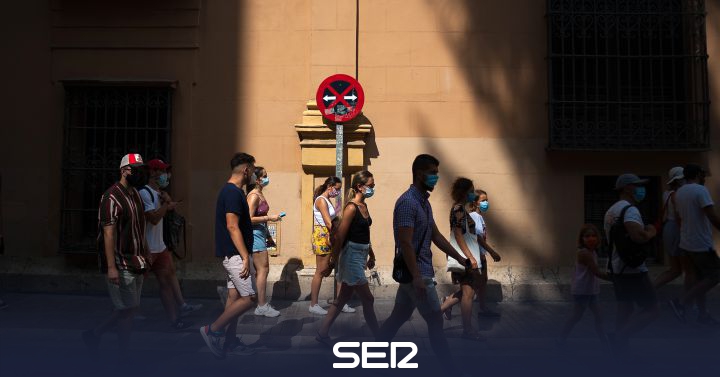Since the start of the de-escalation in June, after spending three months in confinement, infections by Covid-19 have been increasing. In the last fortnight of July and the first week of August the outbreaks have reproduced exponentially and the authorities have been forced to tighten measures to contain the spread of the virus.
The situation is under control and the days when hospitals and primary care were collapsed are over. Even so, epidemiologists and health experts warn that the second wave of coronavirus it’s already close, or it might even be lurking already.
Some regional governments once again imposed a lockdown on their municipalities as they saw the spread of the virus accelerate. Thus, the inhabitants of La Mariña in Lugo and the El Segrià region experienced a confinement at the beginning of summer. Now these areas are out of danger, but its executives have decided to impose restrictions capacity in hotels and shops, as well as family and social gatherings.
Confined areas
However, some places are currently confined, such as the Valladolid municipalities Íscar and Pedrajas de San Esteban, the town of Villarta de los Montes in Badajoz, Totana (Murcia) that has been in Phase 1 since July 23 and the recent population of Aranda de Duero that cannot leave the municipality from this Friday.
The residents of íscar and Pedrajas de San Esteban have already completed a week of confinement and are facing the second in order to contain the spread of the virus after the outbreak of 49 infections confirmed in Íscar and many others in surveillance. For its part, Extremadura Health Council decreed the social isolation of Villarta de los Montes, which in the last day has added 24 new positives and 213 are under study.
Likewise, Totana has been in Phase 1 for more than two weeks and continues despite the remission of coronavirus cases. The last to announce a lockdown is Aranda de Duero, whose inhabitants will not be able to leave the municipal area for two weeks.
The situation of the neighborhood of Las Delicias, in Zaragoza
In the neighborhood of Delicias de Zaragoza, a device is launched with local and national police and social workers who will check ‘in situ’ if those who have been diagnosed with coronavirus or are direct contacts are complying with the isolation or if they have difficulties to comply. During this weekend a technical coordination meeting has been held and the visits could begin between Monday and Tuesday.
As explained by the Minister of Health Sira Repollés, “there is no determined volume of people who are performing confinement badly but we do have the subjective impression – due to the characteristics of the scans that are being carried out in the population – that, not of their own free will but because of the housing conditions or the working conditions that these people have, they are not able to comply with these quarantines effectively“.
If the conditions are not met, stays will be offered in intermediate facilities, such as the Multipurpose Room (in the Zaragoza Auditorium), which has 100 seats. With this measure, They hope to stop this chain of transmission. This device, which is aimed especially at vulnerable groups, is also informative, and could be extended to other neighborhoods.
And Phase 2
Other localities that faced confinement at the beginning of the summer have managed to control the outbreaks, but the authorities have decided to establish a series of restrictions to reduce the impact of the virus and are in Phase 2. These areas are the Pamplona neighborhood of Mendillorri, the Central Region of Zaragoza and the Lower Aragon-Caspe, and the Cinca and La Litera Regions, in Huesca.
This phase involves the free movement of the inhabitants by their provincial terms, but they cannot move around the community or the rest of the Spanish territory. In addition, there is a limitation in the number of members of family and social gatherings to a maximum of 15 and the capacity reduced in bars, shops and entertainment venues to 50%.
Other restricted areas
Other autonomous communities have imposed restrictions in some localities and municipalities, without going back to Phase 2, due to the increase in coronavirus infections in recent days. Besides of mandatory use of the mask both in open and closed spaces, which all regional governments ended up imposing, many have decided to toughen the measures.
Thus, the mayor of Barcelona prohibited meetings of more than ten people, limited the capacity of bars and restaurants to half their capacity, closed cinemas, theaters, nightlife venues and gyms. In the towns of Figueres, Vilafant and Feliu de Llobregat the authorities have done the same and the Generalitat has recommended that its inhabitants not leave their homes if it is not essential. In Lleida, the El Segrià region has already completed its confinement period of more than two weeks due to the considerable increase in regrowth, and is now subject to restrictions such as those mentioned, although without reaching Phase 2.
Also in the health area of A Coruña-Cee measures have been tightened due to the threat of the virus, which in recent weeks have been diagnosed 302 cases. Therefore, the capacity and hours of bars and restaurants, the number of people in meetings, as well as the prohibition of visiting residences are limited.
Finally, the Community of Madrid announced this week the closure of nightlife when locating the main coronavirus outbreaks linked to this activity. In this way, all the hotels, night bars and discos are forced to close at 1.30 in the morning. Likewise, a maximum of 10 people have been limited together in public spaces.
–


